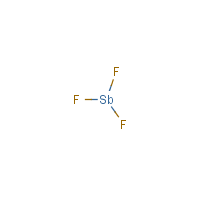Antimony trifluoride
Agent Name
Antimony trifluoride
CAS Number
7783-56-4
Formula
F3-Sb
Major Category
Metals

Synonyms
Antimoine fluorure [French]; Antimonous fluoride; Antimony fluoride; Antimony(III) fluoride (1:3); Stibine, trifluoro-; Trifluoroantimony; Trifluorostibine; [ChemIDplus] UN1549
Category
Metalloid Compounds (Antimony)
Description
White to gray hygroscopic solid; [Hawley] White or light brown powder; [MSDSonline]
Sources/Uses
Used as a catalyst, intermediate, dye (usually in the form of double salts), electroplating agent, fluorinating agent, and to make pottery and porcelains; [HSDB]
Comments
Corrosive to the skin, eyes, and respiratory tract; Antimony compounds can cause injury to the liver, heart, and lungs; [HSDB] A corrosive substance that can cause injury to the skin, eyes, and respiratory tract; Inhalation may cause chemical pneumonitis; Effects in high-dose animal studies include acute tubular necrosis; [MSDSonline] See "Antimony" and linked occupational diseases.
Biomedical References
Exposure Assessment
BEI
Fluorides in urine = 2 mg/L prior to shift or 3 mg/L at end of shift; (Repeated measurements recommended.)
TLV (ACGIH)
0.5 mg/m3, as Sb (2.5 mg/m3, as F)
PEL (OSHA)
0.5 mg/m3, as Sb (2.5 mg/m3, as F)
MAK
1 mg/m3, as F, inhalable fraction
IDLH (NIOSH)
50 mg/m3, as Sb
Adverse Effects
Toxic Pneumonitis
Yes
Hepatotoxin
Hepatoxic (a) from occupational exposure (secondary effect) or (b) in animal studies or in humans after ingestion
Nephrotoxin
Yes
Dermatotoxin
Skin burns
Diseases, Processes, and Activities Linked to This Agent
Processes
Industrial Processes with risk of exposure:
Activities
Activities with risk of exposure: